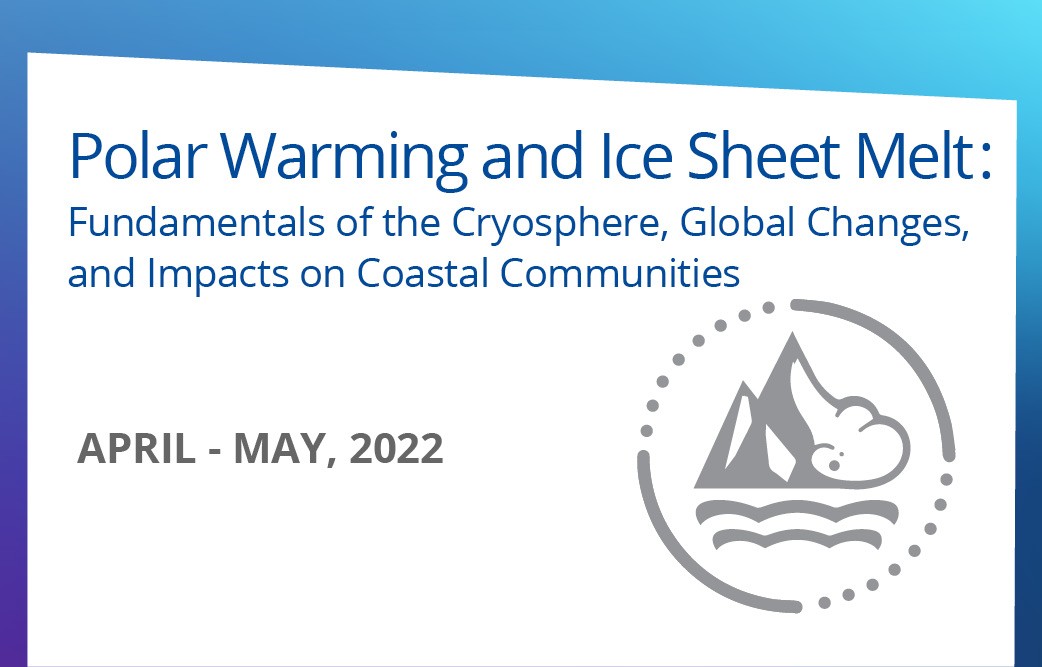teaching
Courses

Columbia Climate School - SPRING 2022 PROFESSIONAL LEARNING COURSE
Polar Warming and Ice Sheet Melt: Fundamentals of the Cryosphere, Global Changes, and Impacts on Coastal Communities
Description:
Communities, governments, and scientists around the world are concerned by the increasing threats to the natural environment, human social systems, and built infrastructure brought on by amplified warming and accelerating environmental change at both poles. The response of ice sheets and glaciers to future warming remains a large source of uncertainty in projections of future sea-level changes. Dramatic losses in Arctic sea ice threatens coastal infrastructure and indigenous communities, all while opening up new shipping lanes and possibilities for resource extraction. Changes in snow and permafrost are shifting water and food resources, while enhancing coastal erosion and shifting carbon sinks and sources. This workshop will provide learners with a basic understanding of the frozen world’s role in the climate system and how changes will impact society across scales.
Learning Objectives/Themes:
Explain the role of ice and snow in the global climate system Understand what drives cryosphere changes in the past and present, and predictions for the future Become familiar with ice sheets, glaciers, the polar oceans, and frozen Arctic landscapes Vignettes of the techniques scientists use to study these polar landscapes Learn how to link remote changes at high-latitudes to your own local community Who is this workshop for?
This workshop is intended for individuals who are interested in advancing their knowledge of climate processes, learning the fundamentals of cold regions science and the research happening in the Arctic and Antarctica by scientists at Columbia University, but also about interactions between environmental change and human systems. Those living in and working with coastal communities currently impacted by sea level change will gain a more holistic understanding about the links between the melting of glaciers and ice sheets to coastal changes around the globe. Decision makers in the conservation and environmental management sectors will be able to utilize this new knowledge on timing and magnitude of expected changes in their own fields.

New York Academy of Science (NYAS) Scientist-In-Residence Program
====== I once again enthusiastically signed up to be a scientist-in-residence (SIR) for the 2020/2021 school year, this time with I.S. 254 in Fordham (Bronx)! I’m super excited to be working with my host teacher this year, Lanipse Rosario, a bright, energetic, and super motivational teacher who is committed to infusing real-world STEM into her 6th grade science classes!
See this map for all of the 2020/21 SIR school sites - impressive!
The Project
In develepment with Lanipse!
In the summer of 2020, LDEO help a virtual NSF Research Experience for Undergraduate (REU) program. I had the immense pleasure of mentoring two dynamic and talented undergraduate students - Isaiah Quattlebaum from SUNY-Orange and Justin Sankey from Sarah Lawrence University.
Greenland Tide Gauge Demo from David Porter on Vimeo.
New York Academy of Science (NYAS) Scientist-In-Residence Program
During the 2019/2020 school year, I was was the scientist-in-residence (SIR) for the NEST+M school in New York City. My host teachers were Stephen Kos and Karol Petrashock at NEST+M (New Explorations in Science, Technology, and Math), co-teachers of five 7th grade science classes.
The Project
Over the course of the school year, we explored the common questions around Earth science, mainly, “How do climate scientists ask questions, make observations, analyze data, and communicate results?”. THrough numerous in-person visits (and virtually following COVID-19 restrictions in April 2020) following along as I
In the fall of 2017, I taught a Data Analysis course for recent particpants of the Secondary School Field Research Program (SSFRP) at Columbia University in NYC. Along with SSFRP director Bob Newton, we held weekly after-school classes for up to 20 self-motivated students with interest in extending data and scientific skills acquired throughout the previous summer.